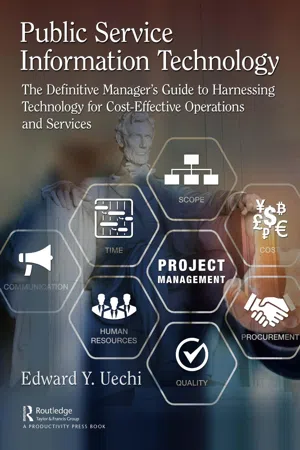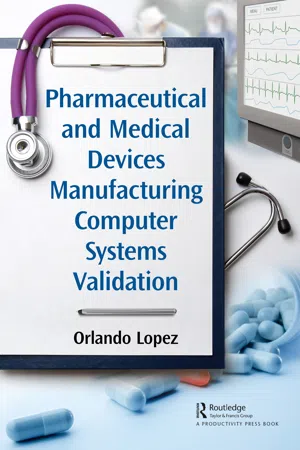Software Development Life Cycle
The Software Development Life Cycle (SDLC) is a structured process used to design, develop, and maintain high-quality software. It typically includes stages such as planning, analysis, design, implementation, testing, deployment, and maintenance. SDLC frameworks help ensure that software is developed efficiently, meets user requirements, and is delivered on time and within budget.
6 Key excerpts on "Software Development Life Cycle"
- Susan M. Houston(Author)
- 2021(Publication Date)
- Productivity Press(Publisher)
...Chapter 5 Software Development Lifecycle DOI: 10.4324/9781003206668-5 It is amazing what you can accomplish if you do not care who gets the credit. Harry S. Truman All software has a specific lifecycle. It begins with the initial identification of a need and ends when it is no longer needed and is disposed. The details of the lifecycle will vary amongst applications and the management processes in place. This chapter will provide an overview of the software development lifecycle (SDLC) which has specific phases that all will go through at one time or another. There is no single model that is correct or that fits all applications. There have been, and still are, multiple different versions of the SDLC. They may have different names for the phases, may move from one to the other in a linear fashion, or repeat them in an iterative manor. But the phases themselves are fairly standard. The standard phases of the SDLC are: Requirements Analysis, or specification Design Configuration, construction, or development Validation, or testing Installation, or deployment Operations and maintenance, or support Retirement, or disposition TIP All software moves through these phases even if each follows a different path. The project manager may only be involved at specific times during a software's lifecycle. They will get involved once the initial project is approved and ready to begin. They may also be involved for projects that arise during operations and maintenance such as upgrades or adding new functionality. If an iterative process is followed, a project manager may be involved for a longer period of time. These are phases of the software's lifecycle, not a project's lifecycle. As mentioned above, there are various methods available for managing the SDLC. If a linear method is followed, the application will move through this one phase at a time. If a more iterative method is used, these phases will be revisited with each iteration...
- eBook - ePub
Public Service Information Technology
The Definitive Manager's Guide to Harnessing Technology for Cost-Effective Operations and Services
- Edward Uechi(Author)
- 2019(Publication Date)
- Productivity Press(Publisher)
...Two general approaches to system development are described along with the costs and benefits of each approach. The public manager will understand scope management and change management – two important areas necessary to manage the development of a computer software program. The chapter highlights a series of documents that are created in the course of developing and operating an IT system. Emphasis is spent on the Software Requirements Specification – the principal document that guides software development. This chapter concludes with a practical approach to keeping team members motivated and involved. System Development Life Cycle Process The System Development Life Cycle (SDLC) process is a formal process for implementing an IT system in general and a computer-based information system in particular. This process is also known as the Software Development Life Cycle, since the computer software component is the central focus of the work. The term “system” refers to all of the components in an IT system (e.g., the computer hardware, the computer software, the computer network, and the non-technological elements). In addition to IT personnel, non-IT personnel need to be aware of this process. Everyone from the technical team to Functional Experts to senior executive leaders will understand what is involved and what to expect in every step of the process. The SDLC process goes through the following nine phases: System Assessment System Definition System Selection and Evaluation System Procurement or Development System Testing System Deployment Data Migration System Operation and Maintenance System Disposal In the first phase, the public manager would have done an assessment as a part of developing the IT Strategic Plan. The public manager would reassess the business needs again when the time is closer to implement the specified IT system. The situation may have changed...
- Orlando Lopez(Author)
- 2018(Publication Date)
- Productivity Press(Publisher)
...Chapter 6 System Life Cycle Introduction A high level of assurance of quality and reliability cannot be attributed to a computer system based basically on a series of tests exclusively designed to confirm the correct function of the application software and its interaction with the infrastructure. * The system life cycle (SLC) is comprised of a sequence of periods that may overlap and/or iterate, as appropriate for the project’s scope, magnitude, complexity, changing needs and opportunities. Each period is described with a statement of purpose and outcomes. The system life cycle processes and activities are selected and employed in a period to fulfill the purpose and outcomes of that period. Life Cycle Model “Framework of processes and activities concerned with the life cycle that may be organized into stages, which also acts as a common reference for communication and understanding.” ISO/IEC 12207:2008, Definition 4.17 The SLC is the “period of time that begins when a product is conceived and ends when the product is no longer available for use”. † The SLC comprises the system development life cycle (SDLC) and, the computer systems operational and maintenance processes. The development life cycle methodology (e.g. waterfall, spiral, Agile software development, rapid prototyping, incremental, and synchronize and stabilize) associated with the SLC contains the software engineering tasks and associated work products necessary for supporting the computer system validation effort. The SLC breaks the systems development process down into sub-periods during which discrete work products are developed...
- Gerhard Greeff, Ranjan Ghoshal(Authors)
- 2004(Publication Date)
- Newnes(Publisher)
...Where applicable this should be provided as part of the system. 14.4 Software Development Life Cycle There are many methodologies for various industries and for various types of developments. Each methodology promotes certain types of tools and even specific tools to perform the prescribed steps. Two of these distinct methodologies for development life cycles are: 14.4.1 Spiral The spiral development model (see Figure 14.2) defines four phases of the project: an idea/need analysis resulting in a vision/scope document; a design phase resulting in a functional specification; a construction phase ending in a complete piece of code; and finally a stabilization phase ending in release of the product. Figure 14.2 Spiral development model 14.4.2 Waterfall Most solution providers use the waterfall life cycle approach for software solution development. The waterfall approach (refer Figure 14.3) helps to understand the extent of the residual risks and allows one to work conscientiously toward reducing those risks. Figure 14.3 Waterfall life cycle approach At the end of each phase, a baseline is established which becomes the platform for the next phase, and until the previous phase is officially approved no next phase should be started, hence delays on any approvals lead to project delays and have cost implications. The execution component is responsible for the final deliverable of the project and is built around pure code development, system configuration, or a combination of both. The waterfall approach is best suited for a simplistic, yet systematic approach to meet the exact requirements of the client. The immediate benefit to the client is the constant realization of the benefits in terms of the expectations of the final deliverable. This approach also ensures that the provider can constantly measure itself to interpret the requirements of – and deliver the best solution to – the client...
- eBook - ePub
- Jay D White(Author)
- 2015(Publication Date)
- Routledge(Publisher)
...Here the steps in the SDLC will be presented from the official Department of Justice Systems Development Life Cycle Guidance Document, which can serve as a model for all other depictions of the waterfall approach. 2 Exhibit 7.1 presents the steps in the SDLC officially used by the Department of Justice (DOJ). Other renditions of the SDLC portray the various steps with either less or greater detail. The DOJ model is fairly comprehensive without going into too much detail and gives a good sense of each of the steps as enumerated by a public agency. The DOJ also insists on strict management controls for the entire life of the project. These include: • Life Cycle Management should be used to ensure a structured approach to information systems development and operation. • Each system project must have an accountable sponsor. • A single project manager must be appointed for each system project. • A comprehensive project management plan is required for each system project. • Data Management and security must be emphasized throughout the life cycle. • A system project may not proceed until resource availability is assured. 3 As one can see from the ten steps in the process and the management controls, the SDLC is indeed a very structured approach to building and implementing systems. It is favored in those situations where large software (and sometimes also hardware) systems need to be designed and built under strict managerial controls that supposedly ensure that the project will not go over budget or over the promised delivery time, and that the project will have almost all, if not all, of the intended functional requirements. Herein lies its paradoxical downfall...
- eBook - ePub
Maximizing Benefits from IT Project Management
From Requirements to Value Delivery
- José López Soriano(Author)
- 2016(Publication Date)
- CRC Press(Publisher)
...Chapter 8 The Systems Development Life Cycle—Build and Test The building phase of the system is the core work of the information system implementation effort. It will normally consume more resources and time than all other life cycle phases. However, despite the significant effort, one must avoid the temptation of thinking that it is the most important phase. When the importance of other development phases is ignored, the result can be a system riddled with errors and inconsistencies, which might require patches and improvised on-the-spot changes to correct analysis and design defects. The analysis and design phases are equally if not more important, and due consideration and effort must be exerted in those stages of system development. In the build and test phase, all activities are aimed at developing the hardware and software (including programming code) needed to implement the established specifications and to resolve the problem for which the project was initiated. It is the phase in which we can see the results of the efforts invested thus far, as we see the analysis and design turned into an information system that meets the various features and functionalities specified. The systems development build and test process is illustrated in Figure 8.1, and the key build and test activities are described in each of the following sections of this chapter. Figure 8.1 Build and test stage diagram. Prepare the Work Environment The first step in building a new system always involves preparing the work environment. The work environment may be more or less complex than the technology being introduced, but the following activities warrant consideration when preparing the work environment. Tools are needed to manage the source files and control versions, as amended. The source file editor may be a general-purpose application or more specialized depending on the source language...





